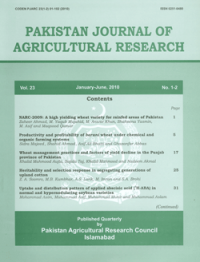GENETIC DIVERSITY ASSESSMENT IN BRASSICA GERMPLASM BASED ON MORPHOLOGICAL ATTRIBUTES
Israr Ali*, Naushad Ali*, Riffat Tahira**, Sardar Ali*, Izhar Hussain* and Sher Aslam Khan*
ABSTRACT
Genetic diversity of 28 Brassica genotypes was studied using different morphological attributes. Data were recorded on days to maturity (DM), -1 -1 plant height (PH), primary branches plant (PBPP), pod length (PL), seed pod (SP), -1 1000-seed weight (1000-SW), yield plant (YPP) and oil (%). Three checks (Pakola, CM and TA), were used to check the performance of collected materials with already available brassica varieties. Significant statistical differences were observed among the tested genotypes based on the studied morphological traits. Among the tested genotypes, genotype Kalabat proved to be superior as compared to other studied genotypes due to maximum level of studied traits like -1 pod length (7.03 cm), seed pod (32.33), 1000-seed weight (5.38 g), seed yield -1 plant (110.8 g) and oil content (52.9%). The highest level of performance -1 recorded by Kalabat in terms of branches plant , pod length (cm), number of seed -1 -1 pod , seed yield plant (g), 1000-seed weight (g) and oil content (%), indicates that this genotype is genetically different and superior than the other studied genotype. Therefore, genotype Kalabat can be either used as variety after adaptability trials over a larger area or included in Brassica breeding programmes as a good source of genetic variation.
To share on other social networks, click on any share button. What are these?






